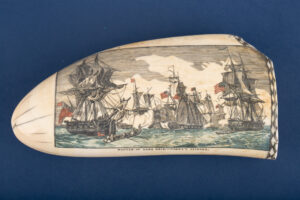EXHIBITION HAS ENDED
When sailors went to sea in the 19th century, they faced difficult working conditions, cramped personal space onboard ship, and voyages that at times could stretch for months or even years. Sailor Made: Folk Art of the Sea, a new exhibition in Mystic Seaport Museum’s C.D. Mallory Building, explores the art that emerged out of this working world, reflecting sailors’ connections to shipboard life, their thoughts about culture on shore, and the souvenirs they created to remember and share the experiences of their travels.
The second of four new exhibitions funded by the Henry Luce Foundation, Sailor Made highlights more than 200 objects from the Museum’s collection, many of which have long been hidden from public view. Each artifact has its own story, and through the work of exhibition curator Mirelle Luecke, Ph.D., much new information has been uncovered about the objects in the show.
 “When stuck in the difficult, dangerous, and sometimes monotonous environment of the ship, sailors used art to express themselves. The designs they inscribed on scrimshaw, the types of household items they made, and the ways they used different materials were all intentions, and tell us something about the sailors themselves, their experiences, and the world they lived in,” said Luecke.
“When stuck in the difficult, dangerous, and sometimes monotonous environment of the ship, sailors used art to express themselves. The designs they inscribed on scrimshaw, the types of household items they made, and the ways they used different materials were all intentions, and tell us something about the sailors themselves, their experiences, and the world they lived in,” said Luecke.
These stories show how creating art enabled sailors to differentiate their labor and leisure time in the otherwise all-consuming work environment of the ship.
To do this sailors turned to art, carving scrimshaw, drawing in journals, sewing intricate embroidery, and creating intricate knot-work, to name but a few of the media on display. Highlights include:
As self-taught artists, sailors engaged with the working world of the ship, imagined their ideal lives on shore, and created objects to commemorate their experiences at sea. This exhibition is a view into the world of the 19th-century sailor, with a few modern examples to show how those impulses and activities continue today in some naval and merchant mariners.
The exhibition is made possible by a grant from the Henry Luce Foundation to support the curation and development of four new collections installations and related programming at Mystic Seaport Museum. These projects will provide new perspectives on the art and ensure the continued preservation and refinement of the collections while also promoting public access.
Access to Sailor Made is included in the Museum’s general admission.